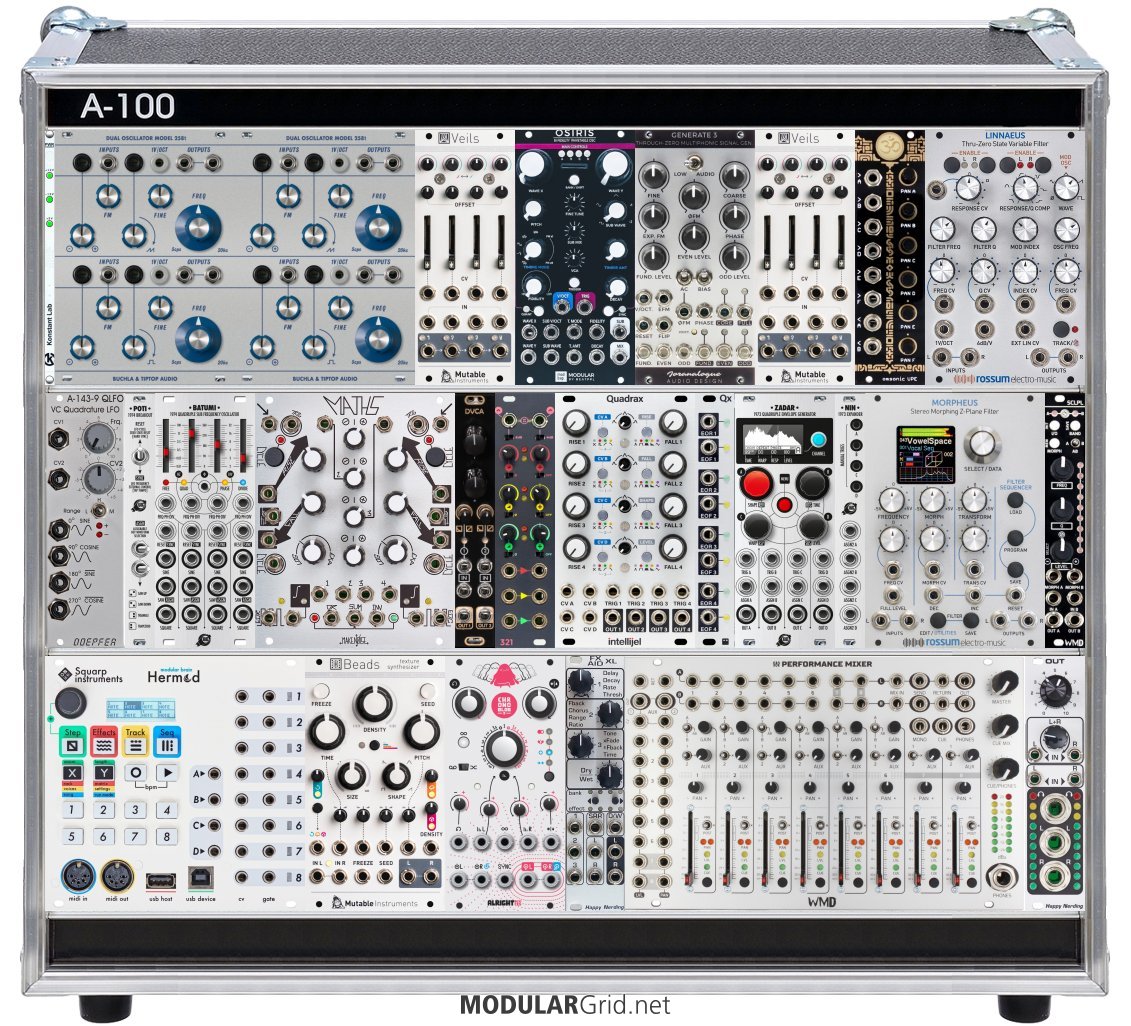Had a look, tore it apart, rebuilt it. Here we go...

LOTS of changes. For one thing, the original had a bad case of "sexy module syndrome" (ie: too many "feature" modules, and not hardly enough "helper" modules to use with those), so I did some major rebalancing of the module types. Also, it was possible to condense some functions down to ONE module, such as using the Hermod (yep...added a sequencer!) as a MIDI interface.
TOP: PWRchekr is the little sliver at left. Then instead of your complex VCO choice, I went with the OG...the Buchla 258, and since Tiptop'll have these for only $200 when they drop in a few weeks (presumably), why not TWO? Well, why not indeed...so there IS two, along with plenty of trickery to make them do lots of Buchla-ish mojo. After that is the first of two quad VCAs, which also sums things down to one or two outputs, depending on what you're up to. After that is a Modbap wavetable VCO with some lo-fi settings, and the ability to blow samples into a microSD card, plus some weird modulation schemes such as phase mod (best known from the Casio CZ-series), a suboscillator, and lots of other tricks. And it's smaller than the Shapeshifter. Then the Joranalogue Generate3 gives you a complex TZFM-able VCO. Then another quad VCA...same deal as before. But the thing after it isn't exactly a mixer; rather, it's an omsonic Panning expander, a fixed-level mixer with stereo panning to stereoize your voicing...mainly because after that point, the audio signal path is stereo out to the main mixer. And right on cue, the first of the three stereo VCFs...Dave Rossum's Linneaus, which is a killer stereo VCF with TZFM capabilities.
MIDDLE: A Doepfer Quadrature LFO is first here; this will be useful for when you want separate LFO outs from the same LFO, but with each out at a 90 degree phase rotation so that you can have multiple sweeping LFOs with different phase relationships (like with the quad VCAs, or quadraturing modulation for the Linnaeus's TZFM scheme). Then four more LFOs with the expander in the Batumi, and after that, Maths. This gets followed by a dual VCA (same topology as the Veils VCAs) and a Frap 321; these are for tampering with modulation behavior, combining mod signals, and so on. Next, Quadrax and the Qx, which lets you do some interesting chained behavior with the four EGs. All your other envelopes are in the Zadar, with its Nin expander. Then an alternate stereo filter, good for some strange timbral behavior (would pair nicely with Beads!) that's also from Dave Rossum and the E-Mu Morpheus. Then the SCLPL is down at the end, which makes it easier to drop into the mixer out as a global filter...and it's ALSO a good pairing with the Beads.
BOTTOM: Hermod...this functions as a MIDI interface AND an eight-channel sequencer, so...yeah, it's got a sequencer now with some serious power. Then "effects", which includes the Beads, plus an Alright Devices Chronoblob2 (stereo delay with an insert point in the feedback path, so it's all set for some serious timbral delay mayhem), and a Happy Nerding FX Aid XL for reverb, flange, etc etc. Then for a mixer, I specced a WMD Performance Mixer because you'll need ample inputs for your sources while, at the same time, having a good AUX send/return setup, a CUE bus, muting, and on and on. Yes, it's big, and it's expensive...but it's a mixer that you can grow into, instead of having to put one mixer in one cab, another in the next, and so forth. This makes it easier to plan expansions. Then down at the end, Happy Nerding again with their OUT module, with transformer balancing, 1/4" TRS outs plus a second headphone preamp (the other's on the WMD mixer, that's the one that can be switched into CUE mode to check various issues on the fly, such as tuning, setting VCF cutoffs, etc). But this also has a second parallel stereo input, so that if you wanted, you could fly in yet another stereo signal from a voice or an FX module.
You'll notice that in a number of cases in here, I made swaps that consolidated several functions. I also got rid of most of the HUGE modules in deference to getting more panel space for modules that were QUITE necessary (all of the VCAs I've added, for example). Other modules got "shrunk" (the Batumi is a good example: 4 LFOs with complex interaction capabilities jammed into a mere 13 hp), and a few just got tossed altogether (for example, the mult...on something this size, you're much better off using inline mults or stackcables). But overall, your primary functions are still intact and, in fact, rather enhanced now that you've got the right supporting modules. Plus the layout makes far more sense by grouping primary functions so that everything moves around the front panel in a pretty good "left-up, right-down" formation for patching clarity. And even with all of the changes, the new/different modules, all that...it still came out only $800 more than your incomplete original, but now the whole cab is full, with lots of possibilities there.

